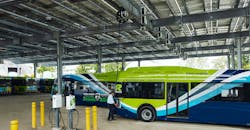We have all heard the adage: “Where there’s a will, there’s a way.” When it comes to making a sweeping shift from carbon-emitting transportation fleets to clean-breathing zero-emission vehicles, the will most certainly is strong. But what about the way?
Rolling out a shiny, new fleet of ZEV buses is only the first step . But building out the right electrification infrastructure to support the ZEV fleet is where well-intentioned organizations face the biggest roadblocks. What good is the ZEV fleet if grid capacity or alternative fuel supply cannot support it? Or if that grid capacity or hydrogen is supplied by fossil-fuel based power generation facilities?
The underlying infrastructure to support widespread, capital cost-friendly, reliable, and resilient electrification simply isn’t up to speed. Despite the groundswell of excitement and support for shifting to electric vehicles in the transportation sector, the electrification of heavy-duty transportation requires much more than swapping out a diesel truck for a battery-electric one, or a hydrogen one for that matter.
In this article, learn about the clear change in fundamentals at play — that is, route planning constraints, emissions regulations, electricity vs. fuel management, idling and pre-conditioning, maintenance cycles, vehicle off-line duration for charging, and other operational KPIs.

